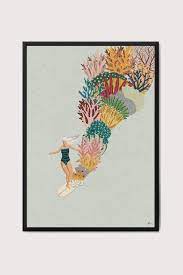The Timeless Elegance of Fine Art Prints: A Celebration of Beauty and Craftsmanship
The Beauty and Value of Fine Art Prints
Fine art prints are more than just reproductions of famous artworks; they are masterpieces in their own right. These prints capture the essence and beauty of original artworks, allowing art enthusiasts to enjoy exceptional pieces in their own homes.
What Makes Fine Art Prints Special?
Unlike mass-produced posters, fine art prints are meticulously crafted using high-quality materials and techniques. Artists work closely with skilled printers to ensure that each print faithfully represents the colours, textures, and details of the original artwork.
One of the key advantages of fine art prints is their ability to make art more accessible to a wider audience. Collecting original artworks can be prohibitively expensive, but fine art prints offer a more affordable way for art lovers to bring beauty into their lives.
The Different Types of Fine Art Prints
There are several types of fine art prints available, each with its own unique characteristics:
- Lithographs: These prints are made using a printing process that involves drawing on a stone or metal plate. Lithographs are known for their rich colours and detailed textures.
- Giclée Prints: Produced using high-quality inkjet printers, giclée prints offer exceptional colour accuracy and longevity. They are often preferred by artists for their ability to reproduce intricate details.
- Etchings: Etchings involve creating an image on a metal plate through a process of chemical etching. The plate is then inked and pressed onto paper to create a print with delicate lines and shading.
The Value of Fine Art Prints
Collecting fine art prints is not only a way to decorate your home with beautiful artworks but also an investment in culture and creativity. Many fine art prints increase in value over time, making them not just objects of beauty but also assets that can appreciate in worth.
Whether you’re a seasoned art collector or someone looking to start their collection, fine art prints offer an accessible entry point into the world of art appreciation. With their exquisite craftsmanship and enduring beauty, these prints have the power to enrich our lives and inspire us every day.
8 Essential Tips for Creating and Preserving Fine Art Prints
- Choose high-quality paper for better results and longevity.
- Consider the printing technique – giclée prints are popular for fine art.
- Ensure accurate colour calibration to maintain the integrity of the artwork.
- Use a professional printing service for best results.
- ‘Limited edition’ prints can increase value and exclusivity.
- Mat and frame your prints to protect and enhance their appearance.
- Consider the size of the print in relation to where it will be displayed.
- Research different printing papers and finishes to find what suits your artwork best.
Choose high-quality paper for better results and longevity.
When selecting fine art prints, opt for high-quality paper to enhance the overall aesthetic appeal and ensure longevity. Premium paper not only showcases the colours and details of the artwork more vividly but also helps preserve the print’s quality over time. Investing in superior paper for your fine art prints can significantly enhance their visual impact and durability, making them a valuable addition to your collection.
Consider the printing technique – giclée prints are popular for fine art.
When investing in fine art prints, it is essential to consider the printing technique used, with giclée prints standing out as a popular choice among art enthusiasts. Renowned for their exceptional colour accuracy and longevity, giclée prints are created using high-quality inkjet printers, ensuring that every detail of the original artwork is faithfully reproduced with precision and clarity. Choosing giclée prints can elevate your art collection to a new level of sophistication and quality.
Ensure accurate colour calibration to maintain the integrity of the artwork.
Ensuring accurate colour calibration is crucial when dealing with fine art prints to preserve the integrity of the artwork. Proper colour calibration guarantees that the colours reproduced in the print closely match those of the original artwork, maintaining its authenticity and visual impact. By meticulously calibrating colours, artists and printers can ensure that every subtle hue and tone is faithfully represented, allowing viewers to experience the artwork as intended by the creator.
Use a professional printing service for best results.
For the best quality and results when creating fine art prints, it is highly recommended to utilise the services of a professional printing service. Professional printers have the expertise, equipment, and materials necessary to ensure that the colours, details, and textures of the original artwork are faithfully reproduced in the print. By entrusting your fine art prints to a professional printing service, you can be confident that you will receive a finished product of exceptional quality that truly does justice to the beauty of the artwork.
‘Limited edition’ prints can increase value and exclusivity.
Investing in ‘limited edition’ fine art prints can significantly enhance their value and exclusivity. By restricting the number of prints produced, artists create a sense of rarity and desirability among collectors. Limited edition prints not only hold their value better over time but also offer buyers a unique opportunity to own a piece of art that is truly special and exclusive. The limited availability of these prints adds an element of prestige and distinction, making them highly sought after in the art market.
Mat and frame your prints to protect and enhance their appearance.
To preserve and enhance the beauty of your fine art prints, consider matting and framing them. Matting provides a buffer between the print and the glass, preventing any moisture or condensation from damaging the artwork. Additionally, a well-chosen frame can complement the colours and style of the print, elevating its overall appearance and making it a focal point in any room. By matting and framing your prints, you not only protect them from environmental factors but also showcase them in a way that highlights their artistic value and craftsmanship.
Consider the size of the print in relation to where it will be displayed.
When selecting a fine art print, it is crucial to consider the size of the print in relation to its intended display location. The scale of the artwork can greatly impact how it interacts with its surroundings and influences the overall aesthetic of a space. A large print may dominate a small room, while a small print might get lost on a vast wall. By carefully assessing the dimensions of the print and the area where it will be showcased, you can ensure that the artwork complements its environment and creates a harmonious visual impact.
Research different printing papers and finishes to find what suits your artwork best.
When exploring fine art prints, it is essential to research and consider various printing papers and finishes to determine the most suitable match for your artwork. The choice of paper and finish can significantly impact how the colours and details of the print are presented, enhancing the overall aesthetic appeal. By selecting the right combination of paper type and finish, you can ensure that your fine art print truly captures the essence and beauty of the original artwork, creating a visually stunning piece that resonates with viewers.


